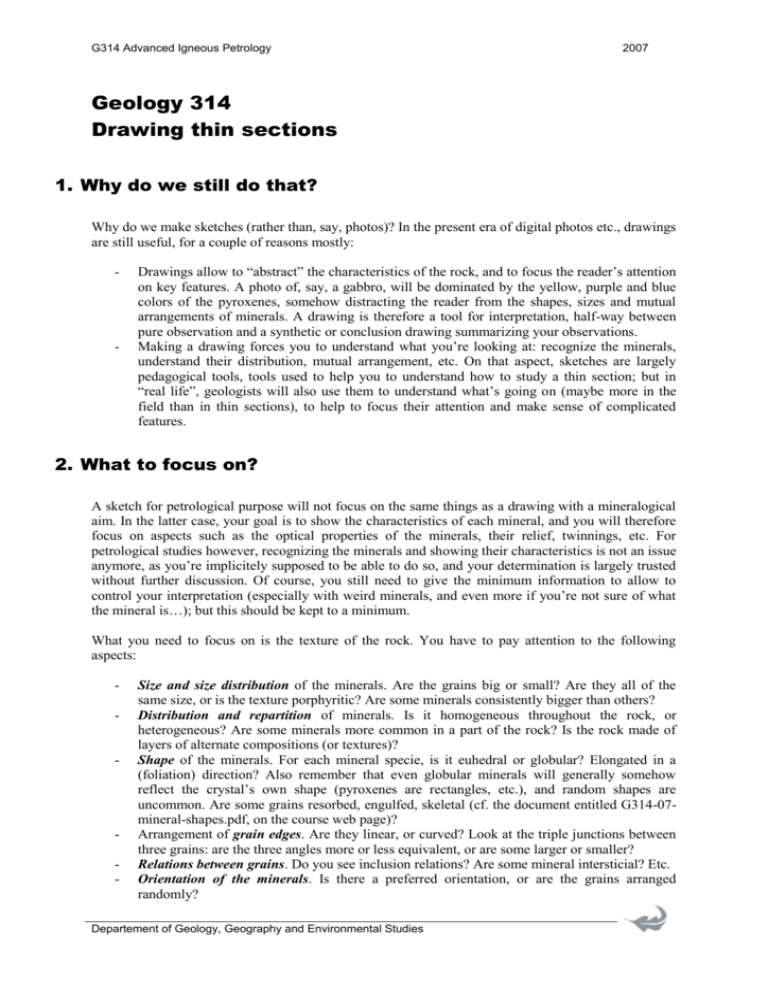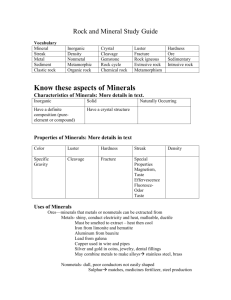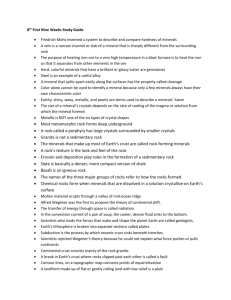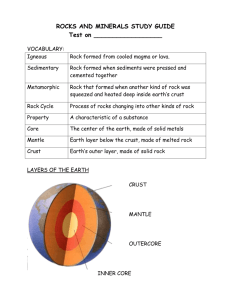Drawing thin
advertisement

G314 Advanced Igneous Petrology 2007 Geology 314 Drawing thin sections 1. Why do we still do that? Why do we make sketches (rather than, say, photos)? In the present era of digital photos etc., drawings are still useful, for a couple of reasons mostly: - - Drawings allow to “abstract” the characteristics of the rock, and to focus the reader’s attention on key features. A photo of, say, a gabbro, will be dominated by the yellow, purple and blue colors of the pyroxenes, somehow distracting the reader from the shapes, sizes and mutual arrangements of minerals. A drawing is therefore a tool for interpretation, half-way between pure observation and a synthetic or conclusion drawing summarizing your observations. Making a drawing forces you to understand what you’re looking at: recognize the minerals, understand their distribution, mutual arrangement, etc. On that aspect, sketches are largely pedagogical tools, tools used to help you to understand how to study a thin section; but in “real life”, geologists will also use them to understand what’s going on (maybe more in the field than in thin sections), to help to focus their attention and make sense of complicated features. 2. What to focus on? A sketch for petrological purpose will not focus on the same things as a drawing with a mineralogical aim. In the latter case, your goal is to show the characteristics of each mineral, and you will therefore focus on aspects such as the optical properties of the minerals, their relief, twinnings, etc. For petrological studies however, recognizing the minerals and showing their characteristics is not an issue anymore, as you’re implicitely supposed to be able to do so, and your determination is largely trusted without further discussion. Of course, you still need to give the minimum information to allow to control your interpretation (especially with weird minerals, and even more if you’re not sure of what the mineral is…); but this should be kept to a minimum. What you need to focus on is the texture of the rock. You have to pay attention to the following aspects: - - - Size and size distribution of the minerals. Are the grains big or small? Are they all of the same size, or is the texture porphyritic? Are some minerals consistently bigger than others? Distribution and repartition of minerals. Is it homogeneous throughout the rock, or heterogeneous? Are some minerals more common in a part of the rock? Is the rock made of layers of alternate compositions (or textures)? Shape of the minerals. For each mineral specie, is it euhedral or globular? Elongated in a (foliation) direction? Also remember that even globular minerals will generally somehow reflect the crystal’s own shape (pyroxenes are rectangles, etc.), and random shapes are uncommon. Are some grains resorbed, engulfed, skeletal (cf. the document entitled G314-07mineral-shapes.pdf, on the course web page)? Arrangement of grain edges. Are they linear, or curved? Look at the triple junctions between three grains: are the three angles more or less equivalent, or are some larger or smaller? Relations between grains. Do you see inclusion relations? Are some mineral intersticial? Etc. Orientation of the minerals. Is there a preferred orientation, or are the grains arranged randomly? Departement of Geology, Geography and Environmental Studies G314 Advanced Igneous Petrology 2007 You can also look for evidence of the following processes: - - Deformation, from the liquid to the solid: feldspar orientation (“mush” textures), sub-grains and ondulose extinction in quartz, domains with grain size reduction (hot, sub-solidus textures), orthognessification (lower temperature, sub-solidus deformation). Mosaic texture (hexagonal grains with 120° triple junctions, typical high temperature annealing texture). Etc. Zoning… Reactions/replacement between/of minerals. Sieving, reaction rims, preserved cores, etc. Secondary minerals (replacing the primary magmatic minerals). Typically chlorite on cleavage planes of mafic minerals, muscovite/white micas (sericite) on feldspars, carbonate/clay veins, etc. Consequently, you’ve to make sure your sketch does show all the above information –and you’ve to make sure that all the features discussed in your description are shown on your sketch, and conversely. It also means that you’ve to select an appropriate portion of your sample: appropriate both for the size (big enough to show all relevant features), and for the place you choose (showing interesting features –not necessarily an average part of the rock, nor the one with the most mineralogical diversity in the smallest possible space!). Examples of excellent sketches are found in J.P Bard – “Microtextures of igneous and metamorphic rocks” (D.Reidel publishing, Dordrecht, 1990). Obviously, you’re not expected to produce sketches of such an astonishing quality… but this shows you where you should be aiming. 3. A worked example The following example is based on sketches by J.-P. Bard (Microtextures of igneous and metamorphic rocks – sketch 6.13, page 141), but the description is mine. It more or less answer the questions that will be asked for prac. 5, but you can also ue it as inspiration for prac 3 and in fact for any exercise involving thin sections! Departement of Geology, Geography and Environmental Studies G314 Advanced Igneous Petrology 2007 This is a holocrystalline, fine- to medium-grained rock (2 mm). The most abundant mineral is plagioclase (50%) (… insert a detailed description here including features such as twinning and possible composition implications, alteration, etc…). Clinopyroxene makes about 30% of the rock; it is … describe…. The remaining 20% of the rock is made of amphibole (hornblende), … describe. The rock shows a crude foliation, marked by the preferential orientation of the plagioclase crystals. Plagioclase forms large laths, with a sub-euhedral shape. They occasionally “lean” on each other (A) or show mutually inclusive relations (B); they form together a framework, whose interstices are filled by the mafic minerals. Some small grain of plag also exist (C), suggesting that there might be a second generation of plag; but this hypothetical second generation is found mostly or only as inclusions into cpx, casting some doubt on its reality. Pyroxene is generally intersticial, found between plagioclases laths (D). It shows no preferential orientation. However, some euhedral to sub-euhedral grains (E) are also observed, demonstrating that cpx was a magmatic mineral. Clinopyroxene occasionally engulfes plagioclase crystals (F) –or contains inclusions of plag (G). This clearly shows that cpx grew after plag. Finally, hornblende is completely intersticial. It shows inclusions both of plag (H) and cpx (I), showing that it was the last mineral to form. Occasional pseudomorphs of cpx (J), or relict cpx with crystallographic continuity in hornblende crystals (K), show that the hornblende is a secondary mineral that formed by a reaction consuming cpx, probably by a reaction of the form cpx + pg + H 2O = Hb. The crystallization sequence in this rock, therefore, is pg > cpx. Hbl formed probably in a completely solid rock, by metamorphic reactions, and is not a primary, magmatic mineral. This order of crystallization can be relatively easily explained using a binary An-Di diagram, that shows that, depending on the rock’s bulk composition, either plag or cpx can be the liquidus phase. In this case, the bulk composition of the rock (around 50% plag) suggests that the sample evolved along a cooling path such as drawn on fig. 2. As the magma cools, it first forms plag; the composition of the remaining magma therefore evolves towards the Di rich side, until it reaches the eutectic. At that point, both plag and cpx crystallize, until the rock is fully solid. Note that in this case, there are no good evidence for Departement of Geology, Geography and Environmental Studies G314 Advanced Igneous Petrology 2007 concertal growth of plag and cpx, unless the hypothetical second generation of plag corresponds to this process? The preferred orientation of feldspars suggest that they grew in a partially crystallized “mush”, and that they record strain pattern or flow direction during cooling. As the rock cooled and its solid fraction increased, the solid crystals formed a rigid framework, precluding further deformation; when the cpx formed, they just filled the irregular holes between the then rigid framework. After complete solidification of the rock, cooling and hydration allowed sub-solidus reactions between cpx and plag, forming the secondary hbl. 1600 Liquid 1553 Liquidus 1500 T oC 1400 Anorthite + Liquid 1392 1300 Diopside + Liquid 1274 1200 Diopside + Anorthite Di 20 40 60 Departement of Geology, Geography and Environmental Studies 80 An





